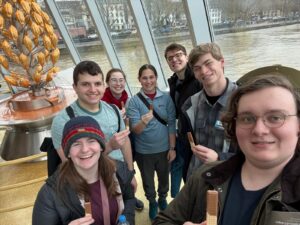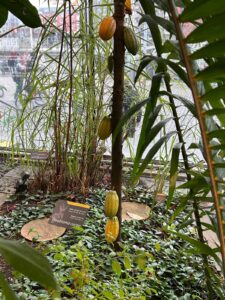The Dark Side of Chocolate
Last week, we visited the Chocolate Museum in Cologne, Germany. During our visit, we sampled chocolate at various stages of production. The journey begins with the cacao bean, which is naturally very bitter in its raw form. Initially, when the bean is still in its seed form, it has little to no resemblance to the chocolate we enjoy. As the process continues, milk and sugar are added, giving the chocolate a slightly grainy texture. However, once fat and vanilla are added for texture and flavor, it becomes a familiar milk chocolate bar.

After our tasting, we explored the museum exhibits, which provided a deeper understanding of the cacao industry. Cacao trees thrive in a narrow belt around the equator due to the warm and humid temperatures needed for their growth. Unfortunately, many of these countries face significant economic challenges, leading to widespread child labor in the industry. In Ghana and Côte d’Ivoire alone, about 1.5 million children are involved in the cocoa production industry. One of the major issues affecting cacao-producing countries is the lack of infrastructure. Poor roads, inadequate schools, and limited access to electricity and water make it difficult for farmers and their families to break the cycle of poverty. On top of that, farmers make very little money from the cocoa they produce—only 6% of the sale price. This, combined with the lack of proper education, means many children are forced to work on cacao farms instead of attending school. This creates a cycle where generations remain trapped in low-income agricultural labor, often under exploitative conditions. Not only does this prevent children from getting an education, but much of the work they do is hazardous. Harvesting cacao pods is physically demanding, often requiring the use of sharp tools and the transportation of heavy loads of beans.

Despite these harsh realities, organizations, governments, and companies are working to address these issues and create safer, fairer conditions for cacao workers. Ghana and Côte d’Ivoire have implemented state-regulated prices to increase security for farmers, but these are still below a livable income. Companies like Fairtrade International have set a minimum price of $2,400 per ton, but again, this is still below the calculated livable income. The Rainforest Alliance is another group whose core standards prohibit exploitative child labor and aim to improve agricultural and environmental practices. Tony’s Chocolonely is a chocolate company actively working to raise awareness about child labor and modern slavery in the chocolate industry. Their mission is to establish a more equitable supply chain by guaranteeing fair wages for farmers and promoting ethical sourcing practices. The company pays the Fairtrade reference price and an additional premium to help improve the living conditions of farmers. They have also implemented Child Labor Monitoring and Remediation Systems (CLMRS) in their cooperatives to raise awareness of child labor and prevent it.
Visiting the Chocolate Museum in Cologne was both enjoyable and enlightening. While chocolate is often seen as a sweet treat, for many families, it serves as their livelihood and primary source of income. Gaining insight into the entire chocolate-making process and its significance for countries in the Cacao Belt underscores the deep interconnection of infrastructure and its far-reaching impact on our lives.
Written By: Melissa
Sources:
https://www.weltladen-offenburg.de/wp-content/uploads/Infoblatt-1-bittere-schokolade-inkota.pdf
https://www.inkota.de/sites/default/files/2024-01/inkota_infoblatt7_mcf_pestizide_web.pdf
https://www.inkota.de/sites/default/files/2020-06/inkota-infoblatt-5-kinderarbeit-schokolade.pdf
https://www.inkota.de/sites/default/files/2023-08/infoblatt-vorreiter-fairness-schokolade-inkota.pdf
